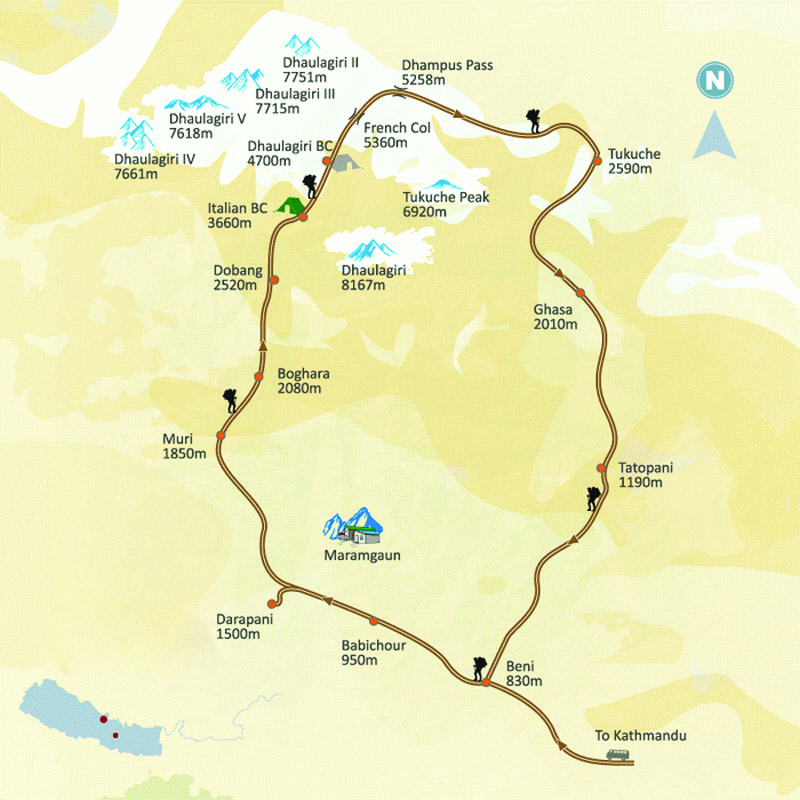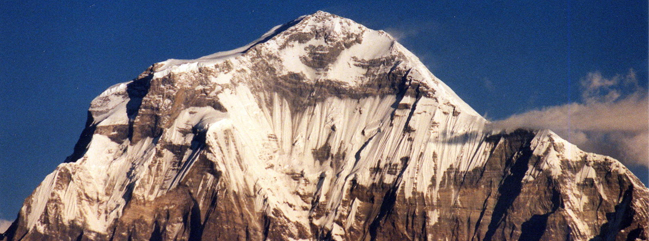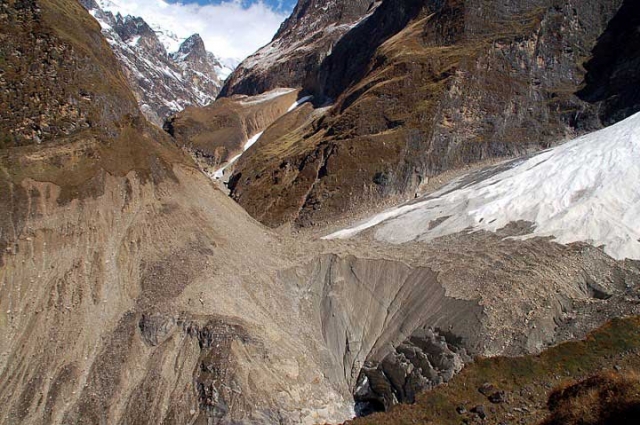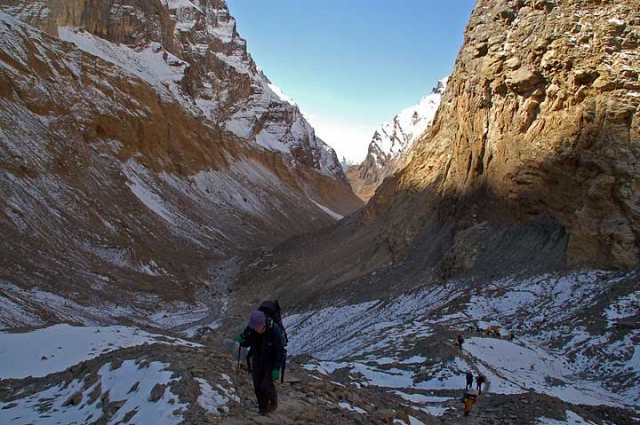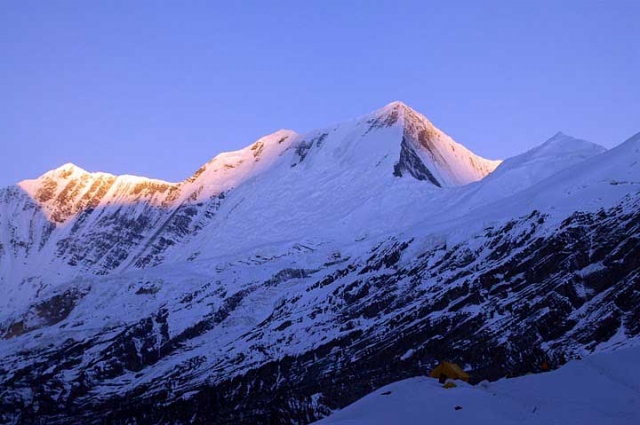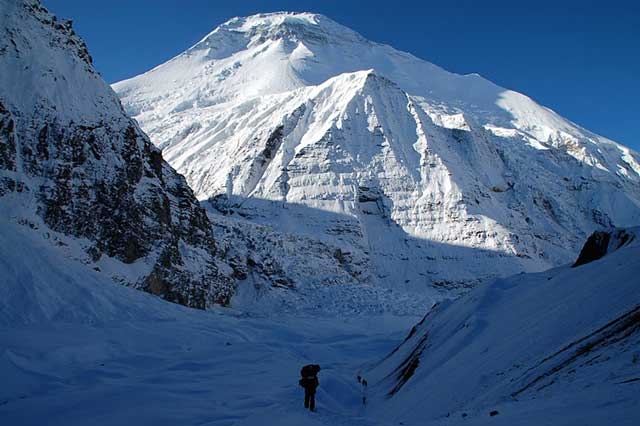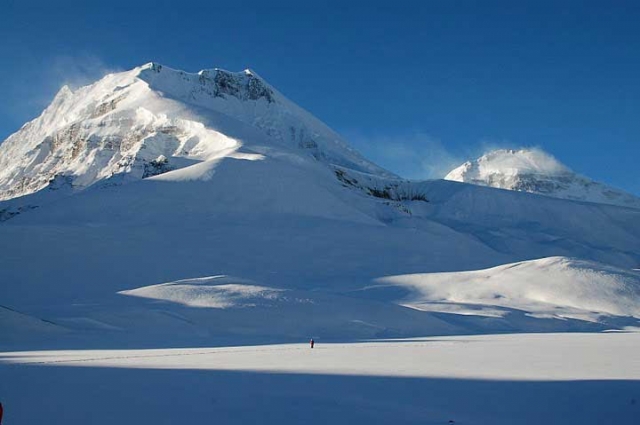Dhaulaghiri was climbed first in 1960 by an international team under the leadership of Max Eiselin, Lucerne. Since I happen to know some of the team members personally, my description concentrates mainly on this ascent. But in this Overview chapter, I try to inform about the present situation.dhaulagiri, dhaulagiri expedition, dhaulagiri expedition, dhaulagir peak, climbing, expedition in nepal
Dhavali giri is Sanskrit and means white mountain. It is located in the west central part of Nepal. On the altitude scale it is number 7 and it is almost the last 8000er to be conquered. The way of the first ascent is the normal route of today. There are however two main possibilities to reach the base camp. Both ways start from south at the small town of Beni (860 m) which can by reached by bus from Pokhara and Kathmandu.
The eastern valley is called Kali Gandaki and was chosen by the French expedition in 1950. Today there is even an airport at Jomosom (2700 m) in this valley. On the west side of this valley is Dhaulagiri, on the east side is Annapurna. The alternative route is the Mayanghdi valley, which was discovered by a Swiss expedition one year later. Today there are commercial trekking tours that climb on one side, reach the base camp and come back through the opposite valley. But there also organized tours that try to reach the summit. Here is a brief description of such a tour that lasts ca. 45 days and costs around $ 7000, including the flight to Nepal and the fee to the summit.
Reckon with a 10 days climb from Beni through Mayanghdi Khola to the BC on the north side at 4650 m. Food and lodging in tents are provided by the organizer. Porters are included in the price. The participants will spend 30 days at and above the base camp. Food will be supplied at the BC, but the ascent of the NE-spur is left to the team member, without guides and at their own risk. 2-men tents are provided, but must be carried and to four sites on the spur and are erected by the members. Some fixed ropes are already there or will be installed by the organization. Artificial oxygen is proved at the BC in case of emergency.
The route between the last camp and the summit does not follow the spur and the French ridge, as in 1960, but follows the ice field that heads directly to the summit and was abandoned by the first ascent because of too much snow.
The way back to Beni may lead over the French-Col and ambush Pass (Thapa Pass). Then follow the Kali Gandaki to the village of Tuktsche (2600 m). Some organizations walk back to Beni, others reach the airport at Jomosom (2700 m).
Day 01- Arrival in Kathmandu airport (1345meters).
There you will be met by our Airport Representative and transferred to hotel by private tourist vehicle. Overnight at hotel.
Day 02- Pre-trip Meeting and Sightseeing around Kathmandu valley.
In the morning after breakfast at 9 AM, we host a Pre-Trip meeting at your hotel in Kathmandu and introduced your trek Leader/Guide mean time and it will provide an opportunity for individuals to ask questions about the your trek and to introduce you to other participants. This includes a final briefing and preparations for the trip.
PLEASE ADVISE US IF YOU WILL BE ARRIVING LATE AND ARE THEREFORE UNABLE TO ATTEND THE PRE-TRIP MEETING.
In THE PRE-TRIP MEETING All passengers MUST bring:
1. Passport.
2. Four copies of Passport size photos each.
3. Travel Insurance Policy.
4. A writing pen
5. Notepad.
After the Pre-Trip meeting and breakfast your sightseeing trip will start at 9.45 AM in the morning. We provide a private vehicle and professional tour guide. We visit Bodhnath Stupa, one of the biggest Buddhist shrines in the world, where we observe Buddhist monks in prayer in the monasteries surrounding the stupa. After Bodhnath Stupa we visit Pashupatinath, the most famous Hindu temple in the country, located on the banks of the holy Bagmati River. Here we see Hindu holy men (sadhus) meditating, pilgrims bathing and occasionally funeral pyres burning on the ghats. We also visit Bhaktapur Durbar Square, which is a collection of pagoda and shikhara – style temples grouped around a fifty-five-window palace of brick and wood. The attraction of the Bhaktapur Durbar Square is The Lion gate, The Golden gate, The Palace of fifty five windows, Art Galleries, The Statue of King Bhupatindra Malla.
The rest of our time in Kathmandu is free for further exploration and some last-minute shopping in Thamel area near by your hotel. Later, we are supplied with our Trek Pack and departure information for tomorrow. Overnight at hotel.
Day 03- Drive to Beni (850meters) by bus 8 hours.
After your breakfast, you drive to Beni. The drive should take 8 hours and you’ll find most of the scenery very enjoyable. Beni is the district headquarters and has a police check post where your trekking permits will be examined. Beni is at the confluence of the Myagdi Khola and the Kali Gandaki. Overnight at tented camp.
Day 04- Trek to Babiachor (950 meters) 5 hours.
Leaving Beni and Kali Gandaki the trek heads west along the north bank of the Myagdi Khola through the village of Beni Mangalghat to Singa and Tatopani (hot springs). Crossing the bridge beyond the village to the south bank of the river, the trail makes a little half loop before crossing another bridge, near the village of Simalchour, back to the north bank from where it continues to the village of Babichor. Overnight at tented camp.
Day 05- Trek to Dharapani (1,400meters) 6 hours.
The valley widens and terraced hills develop on both sides of the river. The trail is fairly level and you pass the village of Shahashradhara, cross the Duk Khola and walk through fields arriving at Ratorunga. From here the valley narrows again and terraces disappear on either side of the river. Continue to the village of Dharapani. Overnight at tented camp.
Day 06- Trek to Muri (1,850meters) 5 hours.
After crossing the river to its West Bank as you leave Phedi the trail starts climbing in earnest and there will be many switch-backs until you arrive at the ridge and the angle of ascent eases. Again the trail climbs steeply to the villages of Muri. Continue your trek to Sibang and Mattim. From here you continue up an incline to the snout of the ridge, descend to the Gatti Khola and reach Phalai Gaon (1810meters). Cross the Dhara Khola to once again emerge on the west bank of the Myagdi Khola and then climb a ridge to the large Magar village of Muri. Overnight at tented camp.
Day 07- Trek to Boghara (2080meters) 6 hours.
Descend a little, cross a stream and continue through terraced fields before climbing a ridge to reach the pass from where you can see Mt. Ghustung South (6465 meters). Descend to the Myagdi Khola and trek along its West Bank to the village of Naura from where you will climb a little before traversing a grassy hill and climbing a steep slope with switch-backs, then descend through a forest and terraced fields to Boghara (2080 meters). Overnight at tented camp.
Day 08- Trek to Dobang (2,520meters) 5 hours.
The trail first descends through terraced fields to a small ridge, then through a forest to Jyardan which is the most remote permanent settlement in this part. After the settlement a high winding path crosses a rocky area which then descends before climbing again to Lipshe where there is on single hut. The trail continues through a forest to Lapche Kharka and then climbs to the level area at Dobang. Overnight at tented camp.
Day 09- Trek to Choriban Khola (3,110meters) 5 hours.
After crossing a wooden bridge out of Dobang the trail ascends a forested area. Soon the west face of Dhaulagiri I (8167 meters) becomes visible through breaks in the trees. Descend to the Myagdi Khola and cross via a wooden bridge to the east bank continue to Chartare. Passing through forests again, you cut across a rocky area and cross a stream to Choriban Khola. Overnight at tented camp.
Day 10- Trek to Italian Base Camp (3,660meters) 7 hours.
Follow a trail to the terminal moraine of the Chhonbarban Glacier and enter the glacier from the right. Tukche Peak (6837 meters) becomes visible straight on; at the far end while the impressive north flank of Dhaulagiri I (8167 meters) dominates the skyline to your right. After a short while you will reach Italian Base Camp (3660 meters), which is also the site of your camp for the night. To the west are the peaks of Dhaulagiri II (7751meters), Dhaulagiri III (7715 meters) and Dhaulagiri V (7618 meters). Overnight at tented camp.
Day 11- Acclimatization and rest day.
We will spend a day here in order to acclimatize and adjust to the thinning of the air. It is recommended that your body acclimatizes to the high altitude and be “tuned” for the even higher altitudes to come. Overnight at tented camp.
Day 12- Trek to Glacier Camp (4210meters) 6 hours.
Set up early in the morning when the weather is expected to be clear. This Trail is prone to stone fall, which passes through a narrow gorge. Today we stay overnight near at glacier. Overnight at tented camp.
Day 13- Trek to Dhaulagiri Base Camp (4740meters) 7 hours.
This is one of our adventurous days to Dhaulagiri base camp. From here you can look up at the impressive north face of Dhaulagiri I (8167 meters) dominating the skyline to your right. To the west are peaks of Dhaulagiri II (7751meters), Dhaulagiri III (7715 meters) and Dhaulagiri V (7618 meters). In front of you is the impressive icefall that descends from the north east col. Overnight at tented camp.
Day 13-42: Climbing Period of Dhaulagiri 8167m.
Day 43: Prepared for coming back
Day 44: Cross French Pass (5360 meters) then trek to Hidden Valley (5200meters) 6 hours.
After the glacier you climb two terraced hills, the first of which runs along the glacier, then cutts across the mountain flank and the moraine you enter a gentle incline on the left from an ablation valley. Climb this gentle slope to the French Pass (5360 meters). A great vista opens up from the French Pass and you will be able to see Mukut Himal (6328 meters), Tashi Kang (6386 meters) and Sita Chuchura (6611 meters), all of which surround the Hidden Valley. To the south is Tukche Peak (6920 meters) and beyond is the massive peak of Dhaulagiri I. From French Pass you continue along the right edge of the Hidden valley losing a little altitude to Thapa Pass (5250meters) between Tukche Peak and Thapa Peak (6,012 meters). Descending from Thapa Pass you will make it to camp at 5200 meters. Overnight at tented camp.
Day 45: Cross Dhampus Pass (5200 meters), and trek toYak Kharka (3,680meters) 6 hours.
Descend from the hidden valley to the Dhampus Pass and continue to Yak Kharka. There is a perfect camp site to enjoy the surroundings. Overnight at tented camp.
Day 46: Trek to Jomsom (2,710meters) 5 hours.
Descend to the village of Marpha, on the west bank of the Kali Gandaki River. Marpha is home to many apple orchids as well as all the various food products made from fruit. Apple Brandy is a local specialty that you may be lucky enough to taste en route. Continue north, up the river valley to the town of Jomsom. Overnight at tented camp.
Day 47: Thirty five minutes morning fly to Pokhara (900 meters) and sightseeing same day.
Today 35 minutes morning flight takes us to Pokhara from Jomsom. Once we arrived at Pokhara airport, we then drive to hotel. In the afternoon we will have a sightseeing tour around Pokhara valley, which covers Fewa Lake, Devi’s water fall, Museum, Tibetan refugee settlement and Gupteshower cave etc. Overnight at hotel.
Day 48: Leisure day in Pokhara.
It’s also spare day in case of bad weather in Jomsom. Overnight at hotel.
Day 49- Drive to Kathmandu by bus 7 hours.
Overnight back at the hotel in Kathmandu by bus. If you are interested in continuing onto Chitwan Jungle Safari, River Rafting Adventure, Kathmandu Shopping Tour or Scenic Everest Flight. Overnight at hotel.
Day 50- Transfer to international airport for your final departure.
The trip ends, our Airport Representative will drop you to the Kathmandu international airport for your final flight departure from Nepal.
NOTE: The above information is a guide and standard template of what we provide. The trek can be customized at your request to accommodate your specific requirements.
NOTE : On adventure trips of this type, weather, local politics, transport or a multitude of other factors beyond our control can result in a change of itinerary. It is, however, very unlikely that the itinerary would be substantially altered; if alterations are necessary the leader will decide what is the best alternative, taking into consideration the best interests of the whole group. Where a change does occur, we do everything we can to minimize its effect, but we cannot be responsible for the results of changes or delays.
Q. I want to climb for Expedition, but there are so many options and the cost is high! Why should I choose Kiwi Sherpa ? What makes you different to other companies out there?
A. As we all know that when you make a decision to climb for expedition, it is one of the most financially challenging trips to come on. Our prices compared to other outfitters that provide the same product, services, if not a lesser product are actually less! We invite you to shop around and compare, both in price and quality. We feel strongly that you will find us to be the best in the business.
One of the main things that set us apart is our attention to detail. Nowhere else you will find a team of people more dedicated to your success! From the time you contact the office to the time you step on the mountain, our customer service is the best.
Our trip prices are much more reasonable compare to many global based companies; it is not because we are economical in service in which we operate. We are local operator therefore we DO NOT re-sell or use second party or agency. Many international companies will take anything from one third to three quarters of the profits this is how your trip price makes huge unusual.
Q. How the Expedition will operate?
A. After meeting all your team and crew in Kathmandu we fly by helicopter, drive by vehicle or fixed wing plane directly to the destination and then we start for trekking. Acclimatizing along the way and relishing in the hospitality provided by our Sherpa friends we reach base camp and after some rest and preparation we begin the ascent. Base camp will be a collection of sleeping tents, as well as a large kitchen and dining tent. We utilize the services of specially trained Sherpa cooks and we import a lot of high quality food to supplement the local produce available. The guides and Sherpas will fix rope on the route and stock the camps with provisions and equipment. By utilizing fixed rope we can climb in average weather, and, if necessary descend to base camp with little problem in case of a major storm. Two or three climbing Sherpas will assist with the load carrying but no more will be engaged in order to avoid clogging the route and spoiling the nature of the climb. When the fixed line is in place, and the two camps are established and stocked, we will climb back up the ropes and make a bid for the summit. Sufficient supplies will be available to support all members. Guides and Sherpas will carry all group gear but members are expected to carry their own personal gear. Radios will be used to co-ordinate the movements on the mountain and provide a safety back-up for the lead team.
Q. Can my friends and family come along to base camp for the expedition?
A. Sure! This is one of the best points to start the expedition, having family and friends trek to base camp to see you off on your journey. Base camp for non-climbers is not a very hospitable place, but we strive to make your guests comfortable and welcome. Guests for the duration of the expedition are allowed on a case by case basis. The reason for this is simple. On the trip, our job is to be climbing, spending time just at base camp can be quite boring sometimes, so we usually encourage guests to trek in at the beginning or end of the expedition, to join you during the most exciting parts of the trip! Contact us for cost and details.
Q. As the trip is so long, can I bring food and other gear not on the list?
A. Of course! Most people on the Expedition, members end up bringing “the kitchen sink”! We encourage you to bring some of your favorite goodies and tech toys, as base camp will become our home for 2 months or so. The more comfortable you are, the more energy you have for the climb, so every little thing helps!
Q. Is there a private trip option too? If yes, how does that work and what are the costs?
A. Doing Expedition is a once in a lifetime experience, we wanted to make sure you have every possible advantage. Some clients enjoy the added privacy and schedule flexibility that a private expedition allows. A private means you will have your own guides, your share of the Sherpa carry staff, a private dining tent, and optional private communication facilities. This allows you to climb at your own pace, and enjoy the mountain on your own terms. The costs vary depending on how many clients there are in your private group. Please contact the office for details.
Q. Are the skills/prior experiences required for this climb?
A. Simply, You cannot just decide to write a cheque and go and climb for Expedition ! A comprehensive climbing resume is required to join our team. The most required factor on our ‘Kiwi Sherpa’ is that the participants must have a solid understanding of mountaineering skills. This should include previous high altitude experience of at least 6,000 meters, mixed with a multitude of Alpine mountaineering and, preferably, you will have taken part in a previous 8,000-metre expedition. Please let us know if you want us to arrange training program in some of the 6000 and 7000 meters peaks in Himalaya before your expedition begin.
Q. What is the conditioning level needed for this climb?
A. You should be in the best shape of your life! This is our longest expedition of the year. It requires patience, stamina, mental fortitude, and a strong will. Summit day can sometimes be over 20 hours long! Day by day the challenges are different, but the more prepared you are, both mentally and physically, the smoother your trip will go.
Q. In a team, how many climbers will be on this expedition?
A. Maximum 10 members can be included on our Kiwi Sherpa. This is to ensure that we can maintain safety and our attention on detail. There may be more in base camp and in the camps on the mountain if there are private expeditions, but they will generally travel separately from the main team.
Q. Will I be sharing a tent or room with other climbers? Is there a single room option on this trip?
A. You will have your own tent in base camp, but on the mountain, you will be sharing a tent with others. We generally book you in to a single room in the hotel in Kathmandu whilst it is twin share in the lodges on the trek into base camp. A single supplement is available. Please contact us for further details.
Q. How heavy will my pack be?
A. It will depend on the day. On a “carry” day, where you are moving your personal gear between camps, your pack can be 20-40lbs, equal to 9-18kg , sometimes higher if you choose to carry more of your equipment. On “move” days, the weight goes down significantly, to 10-15lbs., 5-7kg.
Q. What kind of food do you have on the mountain? Or at the base camp?
A. All these will depend on what camp we are in. In the base camp, we import tons of food from Kathmandu. So don’t be surprised by our sushi nights, fresh muffins, yoghurt for breakfast, and pizza! On the mountain, we usually have a wide variety of meals; these are significantly tastier than freeze dried, as they are real food and ready to heat and eat! At Camp 2, our advanced base camp, we have Sherpa cook staff, who prepare more ‘base camp like’ food. Pizza, pasta, eggs and bacon! We work hard to make sure our food is second to none.
Q. How long will be a typical day on the mountain?
A. It depends on the day and your level of acclimatization. At the beginning of the trip, everything seems slower and longer, but as you get more adjusted to the mountain, the days go quicker. Average days can be 5-10 hours long. Summit day can be up to 20 hours long.
Q. Is communication possible on the expedition? If yes, what its type?
A. Experience has shown how important it is on expedition to be able to talk to every team member, at all times. If you join Kiwi Sherpa on expedition, you will have a dedicated radio. Each Sherpa will also have his own radio, so that at all times we can keep in touch with everyone, and everyone can keep in touch with each other.
Base Camp is equipped with a lap top and high speed satellite connection. The satellite communications are also used to send back regular reports, every couple of days, to Kiwi Sherpa office.
Q. What sort of hotels do we stay at in the city?
A. We use standard rooms from three/four star hotels in Kathmandu with breakfast included.
Q. What time should I arrive and where do I meet my guides?
A. There will be an Kiwi Sherpa representative at the airport to meet you, and the first of many team briefing occurs in the evening of day 1 and 2 in Kathmandu with our local Sherpa guides.
Q. How much should I budget for this expedition? How much cash should I plan to bring?
A. Since this is our biggest and longest trip, we usually suggest our expedition members to bring USD$2000 -$3000. This will cover everything from gifts, to bottled drinks, tips, and anything else that catches your eye on the trail. ATM cash machines work in Kathmandu, but only pays the local currency, Rupees.
Q. How much should I tip my guide staff?
A. This is a difficult thing to gauge. We have seen everything from 100USD to 15,000USD for an Expedition tip. Tipping is not required, but a small way to show your guides thanks for their help. The level of the tip should reflect the level of personal involvement with your guide.
The suggested tipping are as follow:
– Allow $150-250 for general non-sherpa crew who stay at base camp.
– Allow $200-350 for sherpas who go up to the base camp.
– Summit climbing Sherpa US$ 1000 – 1500 per Sherpa.
Q. What if I arrive early or depart late?
A. As long as possible, we request you to arrive in Kathmandu on the assigned date, to assure your baggage makes it on time, and you have time to recover from jet lag before trekking. It is hard to catch the group if you are arriving late and still waiting for lost baggage! We can arrange extra nights in the hotel. Many people depart from our Nepal expeditions later, to enjoy the sights and sounds of Kathmandu, but do keep in mind that this is long expedition and we find that people want to head home as quickly as possible after the climb finishes.
Q. Are there any entry or visa requirements?
A. Yes there are. Be sure to have the suggested USD amount in cash for your visa application and have a passport, photos for your arrival in Kathmandu. You will receive your visa at the airport, and we will add extra days later, as you are only ever issued a 90 days visa when you first arrive.
Q. Could I have my own personal Sherpa?
A. In our normal expedition you carry your personal equipment; sleeping bag, mattress/s, down suit, snacks, clothing while the sherpas carry the meals, gas, stoves, tents and oxygen. The team climbs together between camps and a climbing sherpa will also accompany you to the summit. This is a good level of service, and suits most people, however if you want an additional climbing sherpa to assist with your personal equipment and to climb with you all the time, we can provide. Please contact us.
Q. What kind of insurance do I need?
A. We invest in insurance coverage for commercial liability and medical and disability insurance for our employees and Sherpas while participating on our programs. We cannot insure you for your personal needs, but we do expect you to be as fiscally responsible as we are. We strongly recommend that you insure yourself against potentially expensive difficulties that may arise. First, trip cancellation insurance may provide financial relief should you be forced to withdraw from the climb before it even happens. Next, make sure you have adequate traveler’s medical and evacuation insurance for coverage should you have a problem during the trip. Medical care and evacuation from mountain can be expensive.
For the Rescue and Evacuation, Kiwi Sherpa strongly recommends that you purchase a Global Rescue membership to protect yourself and your family. We give you our word that you will be safer as a result. We are an authorized agent of Global Rescue, click here to sign up the membership plan today.
Q. Are the Kiwi Sherpa staff insured?
A. Our company insures all our trekking staff, including guide, cook, sherpa and porters.
Q. Can’t find your question here?
A. Contact us for further information!
Cost Includes
• Airport transfers (domestic and international both)
• Press conference arrangement.
• 5 nights hotel accommodation at Hotel Yak and Yeti or similar with breakfast.
• Climbing Permit fee form Mt. Dhaulagiri and Annapurna consrvation Area entry permit fee.
• Food & Fuel during the trek and expedition period.
• North Face or similar quality high altitude tent for higher camps
• Single tent for each member, staffs, climbing Sherpa at the base camp.
• 5/5 bottles of oxygen per member and guide with mask and regulator.
• Staff: Base camp Guide, Cook, Cook helper.
• Porters/Yaks to and from base camp.
• One high altitude Sherpa for one climber (1:1) who assist you whilst on climbing and summit attempt as well as carries food and gears to high camps.
• Government liaison officer, his insurance, daily allowance, equipment allowance and flight fares.
• Flight fare for member and staff (Jomsom – Pokhara).
• Insurance, equipment allowance, wages and daily allowance for expedition staffs.
• All camping equipments: sleeping tents, mattress, dining tent, toilet tent, mess tent, store tent, table & chairs and other necessary kitchen utensils whilst on trekking and expedition.
• Group climbing equipment such as necessary fixed rope, ice screws, ice bars etc.
• First Aid kit bag, trekking map & duffel bag.
• Solar panel at the base camp.
• Restop toilet bag.
• Satalite phone (Pay Call).
• Walkie Talkie for each staff and member.
• Mountain cans cleaning at high camps.
• Cargo transportation to supply the food and gears to Beni and back from Jomsom
• All ground transportation
• Necessary documentation and governmental official paper works.
• All applicable taxes as per the government rules and regulations.
Cost Excludes
• Personal climbing gears.
• Extra hotels in Kathmandu (after 5 nights).
• Personal climbing insurance which covers travel, medical, accident, evacuation etc.
• Lunch & dinner in Kathmandu.
• Emergency Rescue evacuation by helicopter.
• Applicable permit fees and custom charges for using communication equipment, commercial filming, satellite phone, radio etc.
• Carrying bonus + Summit bonus for climbing Sherpa
• Personal expenses such as laundry, telephone, e-mail, etc.
• Bar and beverage bills..
• Custom clearances in Kathmandu International airport.
• Gratitute (tip) for the staff etc.
